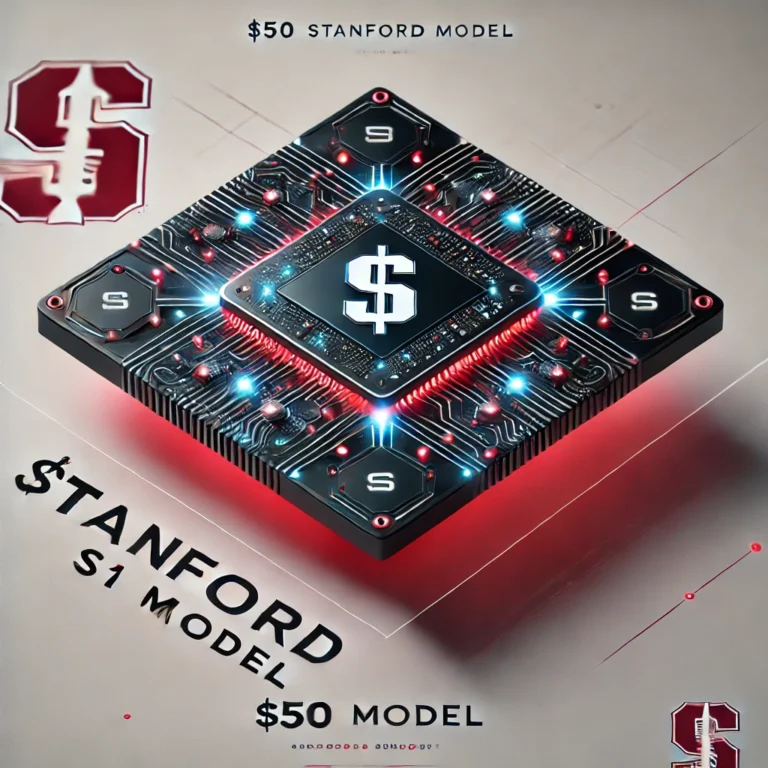Breakthrough Brain-Machine Interfaces: What Investors Should Know About Neuralink and Synchron
Introduction: Why Brain-Machine Interfaces Matter to Investors
Brain-machine interfaces (BMIs) are transitioning from research labs to real-world markets, marking a technological inflection point that forward-looking investors cannot ignore. Once confined to academic papers and speculative tech talks, BMIs are now entering clinical trials, gaining FDA recognition, and securing funding from major venture and government sources. Companies like Neuralink and Synchron are pushing boundaries that redefine how humans interact with machines.
What is fueling this acceleration? It is the convergence of neuroscience, AI models, chip miniaturization, and computational neuroscience. These technologies are evolving together, making the brain a viable input and data source for medical, defense, and consumer applications. As aging populations expand and demand for neurorestoration grows, new markets are opening in cognitive care, mobility, and beyond.
For investors, BMIs represent a frontier technology category where scientific discovery intersects with scalable infrastructure and commercial use cases. This blog outlines the leading players, emerging opportunities, and key considerations for positioning capital in the neural economy.
To understand the scale of this opportunity, see the chart below showing the projected global market growth for neural tech through 2030. This chart visualizes the strong upward trajectory in BMI-related markets, signaling where value creation is likely to accelerate.
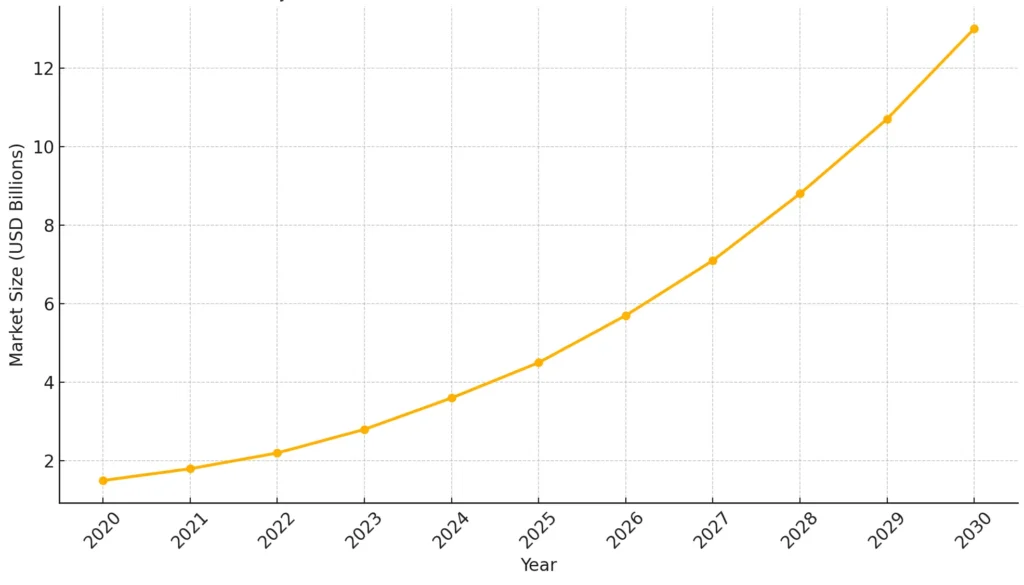
Understanding Brain-Machine Interfaces for Investors
Brain-machine interfaces (BMIs), also known as brain-computer interfaces (BCIs), are technologies that create a direct communication pathway between the brain and external systems. For investors, understanding how BMIs function—and how they’re categorized—is crucial to identifying viable business models, market segments, and risk profiles.
BMIs fall into two broad categories: invasive and non-invasive. Invasive systems, like Neuralink’s implantable device, require surgical insertion into the brain and typically offer higher bandwidth and precision. These are being explored for high-stakes applications like restoring movement in paralysis or enabling direct thought-to-text communication. Non-invasive BMIs, such as those developed by Emotiv or Kernel, use EEG sensors on the scalp. They are safer and more accessible but offer lower resolution, making them ideal for wellness, gaming, or consumer AR/VR.
The strategic value of BMIs extends across several verticals:
- Healthcare (neuroprosthetics, stroke rehab)
- Defense (cognitive enhancement, silent communication)
- Human-computer interaction (AR/VR control, productivity apps)
For investors, BMIs are not just a biotech niche—they are foundational technologies in the emerging neural economy, with multiple on-ramps for growth-stage capital deployment.
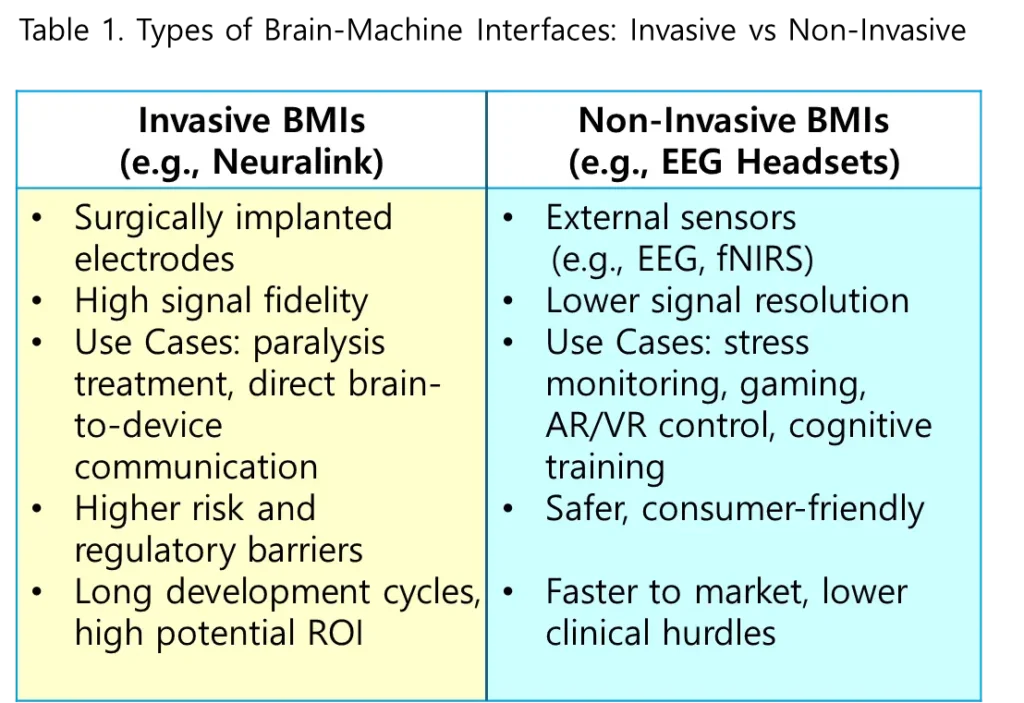
This side-by-side comparison highlights the key trade-offs between surgical and non-surgical BMIs, including signal quality, safety, use cases, and commercialization pathways.
Neuralink vs. Synchron: Comparing Leading Brain-Machine Interface Companies
In the current brain-machine interface landscape, two companies dominate both media attention and investor interest: Neuralink and Synchron. While they share the ambition of enabling brain-to-device communication, their approaches—and implications for investors—differ significantly.
Neuralink, founded by Elon Musk, focuses on a high-bandwidth, fully implantable BMI that connects directly to the cerebral cortex. Its surgical device, the “Link,” aims to restore communication and motor functions in patients with paralysis, with eventual applications in memory enhancement and even AI integration. Neuralink’s strength lies in ambition and funding scale, but it faces high technical risk, ethical scrutiny, and an extensive regulatory path due to the invasive nature of its procedure.
Synchron, by contrast, takes a minimally invasive approach using a “stentrode” delivered through the bloodstream—avoiding open-brain surgery altogether. It has already achieved FDA breakthrough device designation and implanted humans in clinical trials. Synchron is advancing quickly through medical channels, making it more viable in the near term for healthcare-focused investors.
For investors, the contrast is clear: Neuralink offers a moonshot with long-term upside, while Synchron presents a realistic, lower-risk pathway with near-term applications. Both serve as bellwethers in a market where technical architecture directly shapes commercial potential.
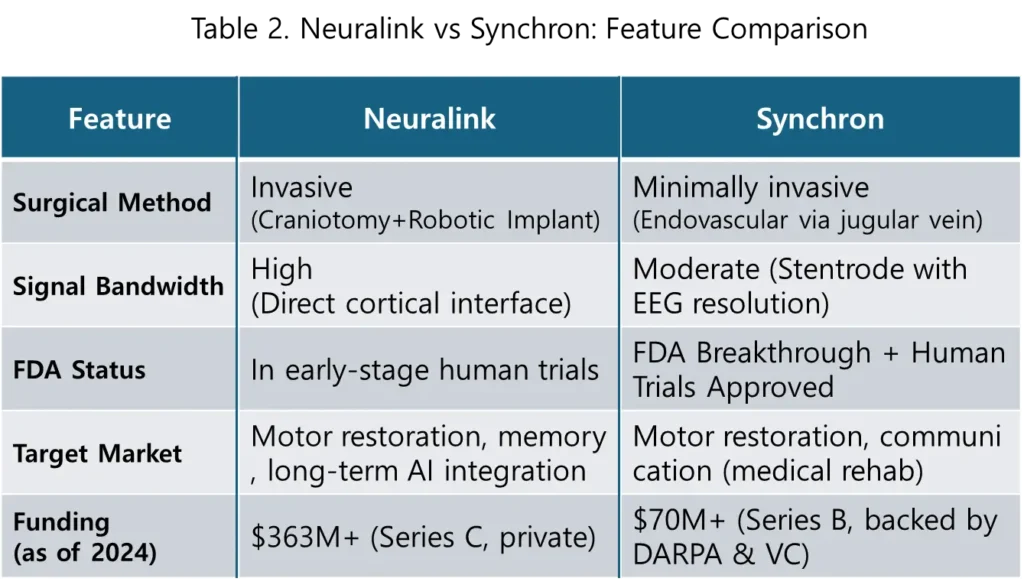
Investment Opportunity #1: Brain-Machine Interfaces in Healthcare
Healthcare is currently the most advanced and investable frontier for brain-machine interfaces (BMIs). As aging populations and neurological disorders rise globally, the demand for solutions in neurorehabilitation, motor function restoration, and cognitive enhancement is accelerating. BMIs are positioned to transform treatment for conditions like paralysis, ALS, Parkinson’s disease, and stroke.
Startups like Synchron are already targeting this space with FDA-cleared clinical trials. Their stentrode system allows paralyzed patients to control digital devices through thought, offering a dramatic improvement in quality of life. Similarly, Neuralink’s long-term ambition includes restoring motor control by reactivating neural pathways, though it’s still in early trial phases.
Beyond movement, memory prosthetics and cognitive stimulation are emerging subfields. In a DARPA-funded study, neural implants improved memory recall by over 30%—a potential breakthrough for Alzheimer’s treatment. Companies like Kernel and NeuroPace are also exploring non-invasive brain modulation for conditions like depression, epilepsy, and PTSD.
From an investment perspective, healthcare BMIs present a compelling combination of clear clinical need, early adoption pathways, and insurance reimbursement potential. While regulatory processes are complex, the FDA’s Breakthrough Devices Program offers a fast-track route for BMI startups with strong medical data. This sector is likely to lead BMI commercialization, making it a logical entry point for investors seeking high-impact, mission-driven opportunities.
Investment Opportunity #2: BMIs in Human-Computer Integration
Beyond healthcare, brain-machine interfaces are unlocking a new paradigm in human-computer interaction, where thoughts can directly control digital systems. This opportunity is especially relevant in the race to develop intuitive input methods for AR/VR platforms, wearables, and ambient computing environments.
Companies like Neurable and NextMind (acquired by Snap Inc.) are pioneering non-invasive BMI headsets designed for real-time digital interaction. These devices can detect user attention, intention, or mental workload—making them valuable for consumer tech firms seeking more immersive user experiences. Meta has also confirmed research into wrist-based neural input, signaling a shift toward thought-adaptive interfaces in its metaverse ecosystem.
This “brain-as-a-platform” model represents the next interface layer—one that could replace or complement voice, gesture, and touch. For investors, this space offers faster development cycles than medical BMIs, fewer regulatory constraints, and broader market appeal across gaming, productivity, and social computing.
While technical resolution is lower than surgical BMIs, the commercial scalability is higher. Early-mover startups that build developer ecosystems, software SDKs, or plug-and-play neurointerfaces will be well-positioned to power the interface economy of the 2030s.
Investment Opportunity #3: Military and Defense Applications of Neural Tech
Brain-machine interfaces have attracted significant interest from defense agencies, particularly as nations race to enhance battlefield performance, decision-making speed, and autonomous systems coordination. In the U.S., the Defense Advanced Research Projects Agency (DARPA) has led the charge, funding BMI research for over a decade through programs like Next-Generation Nonsurgical Neurotechnology (N3) and Silent Talk.
These systems aim to enable covert communication, drones controlled by thought, and even collaborative combat decision-making without spoken words. While many of these applications remain in prototype stages, their dual-use potential makes them attractive for long-term strategic investment. Technologies developed for military use often transfer into healthcare, industrial robotics, or emergency response markets.
From an investor standpoint, the defense segment offers capital-intensive contracts, government funding de-risking, and early validation of cutting-edge platforms. Companies working on high-fidelity signal decoding, secure neural data transmission, and neuro-enhanced situational awareness could become vital suppliers in a future shaped by AI-assisted command systems and neural feedback loops.
Defense may not be the largest BMI market today, but it is likely to serve as a catalyst for breakthroughs and institutional adoption at scale.
The Hidden Layer: Infrastructure Behind Brain-Machine Interfaces
While front-end brain-machine interfaces attract attention, the real enablers of the neural economy lie beneath the surface—in the chips, data pipelines, and AI models that power them. For investors, this infrastructure layer offers scalable, defensible, and often underappreciated opportunities.
BMIs rely on high-resolution neural signal acquisition, which requires specialized low-noise amplifiers, neural sensors, and edge AI processors. Companies like Cerebras, BrainChip, and SynSense are developing ultra-efficient chips tailored for brain-signal decoding and low-latency neural processing.
Signal interpretation also depends on neural data algorithms, many of which use deep learning to map brain activity to intention. These decoding engines, trained on increasingly large datasets, are expected to operate in real-time across edge devices, cloud platforms, and even closed-loop feedback systems.
Add to this the emergence of neuroclouds—platforms for storing, securing, and synchronizing brain data—and the opportunity widens. The companies that provide the “neural stack” will play a similar role to what AWS, Nvidia, and Qualcomm did during the smartphone and AI booms.
Infrastructure plays may not be as visible as the devices themselves, but they are likely to yield high-multiple, B2B-focused returns as BMI adoption scales across industries.
Here is the Neural Tech Stack Architecture diagram, illustrating the layered structure from hardware components to cloud-based AI and neural operating systems. This helps investors visualize where to “buy the picks and shovels” in the emerging brain-machine interface economy.
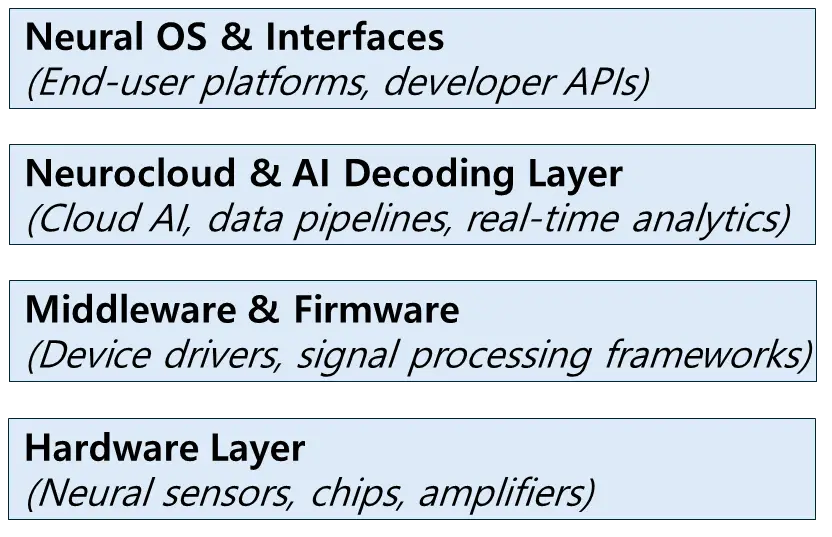
Risks and Challenges in Investing in Neural Tech
While the promise of brain-machine interfaces is enormous, the path to commercialization is filled with significant risks that investors must weigh carefully. Unlike conventional software or consumer hardware, BMIs intersect with healthcare regulations, human safety, and data ethics, creating a complex investment landscape.
Regulatory approvals—especially for invasive systems—can span years and demand multimillion-dollar clinical trials. Even non-invasive devices targeting wellness or productivity can be scrutinized for overstated claims or biometric data handling. Companies that pursue direct-to-consumer BMIs may face evolving FDA and FTC frameworks around mental health and neurofeedback products.
Data privacy is another critical concern. Brain data is uniquely sensitive—it can reveal not just health conditions, but emotional states, attention, and even intent. As neurocloud platforms emerge, the debate around cognitive liberty and surveillance will intensify.
From a capital strategy standpoint, investors should prepare for long development timelines, potential public backlash, and the possibility of needing to pivot from clinical to non-clinical applications. High reward comes with high uncertainty—and in neural tech, timing and positioning are everything.
How to Evaluate Brain-Machine Interface Startups
Investing in brain-machine interface (BMI) startups requires a different lens than traditional SaaS or hardware plays. The intersection of deep tech, neuroscience, and regulatory complexity means that technical promise alone is not enough. Investors need to assess a company’s maturity across several strategic dimensions.
Start with technical readiness: Is the core BMI technology in preclinical research, early trials, or human use? Look for working prototypes, not just pitch decks. Evaluate the signal fidelity, latency, and reliability of the interface—especially if the solution involves real-time decoding.
Next, scrutinize the intellectual property portfolio. Strong BMI startups typically hold patents in neural signal processing, chip design, or bio-compatible materials. IP defensibility is a key barrier to entry and a major acquisition driver.
Regulatory positioning is also vital. Has the startup initiated an FDA pathway? Are they aligned with reimbursement codes or targeting markets that allow for off-label applications? These factors heavily influence commercialization speed.
Finally, understand the business model fit: Are they building a full-stack system, licensing tech, or pursuing strategic partnerships? Alignment with adjacent platforms (AR/VR, robotics, healthcare) can signal a more durable revenue model.
The smartest BMI bets combine scientific rigor with commercial realism.
Conclusion: Positioning Your Portfolio for the Neural Tech Decade
Brain-machine interfaces are no longer science fiction—they are a fast-emerging asset class with real-world momentum across healthcare, defense, and computing. For investors, this is not just another tech cycle. It’s a foundational shift in how humans interact with machines.
From Neuralink’s moonshot ambitions to Synchron’s medical traction, and from infrastructure plays to ethical frameworks, the neural economy is forming its first investable layer. The winners will be those who align capital with clinical outcomes, platform integration, and long-term defensibility.
As with all paradigm shifts, timing and insight matter. The decade ahead will define the leaders in this space. Smart investors will look past the hype and place bets on companies building the bridges between biology and computation.
📚 Reference List
- Abiri, R. et al. (2020), A Review on Neuralink: Trends in Brain-Machine Interface Technologies, Frontiers in Neuroscience.
- DARPA (2019), Next-Generation Nonsurgical Neurotechnology (N3) Program, DARPA.
- Ezzyat, Y. et al. (2018), Closed-Loop Brain Stimulation Enhances Memory, Nature Scientific Reports.
- Jiang, L. et al. (2019), BrainNet: A Multi-Person Brain-to-Brain Interface for Collaborative Problem Solving, Scientific Reports.
- PitchBook (2023), Inside the Surge in Brain-Computer Interface Startup Funding, PitchBook News.
- Statista (2024), Projected Global Neurotechnology Market Size (2020–2030), Statista.
- Synchron Inc. (2021), Synchron Receives FDA Approval to Begin U.S. Human Trials, Synchron Newsroom.
- Wolkenstein, A., & Seitz, R. J. (2023), Regulatory Challenges of Implantable BCIs in the U.S. and Europe, Neuroethics and Policy Journal.
⚠️ Investment Disclaimer
The information presented in this portfolio allocation is for informational and educational purposes only and does not constitute financial, investment, or legal advice. It is not intended as a recommendation to buy, sell, or hold any securities or investment products. The allocation model reflects general market trends and publicly available research at the time of writing, and may not be suitable for all investors. Please consult with a licensed financial advisor or professional before making any investment decisions.
🔑 Keywords:
- brain-machine interfaces for investors
- brain-computer interface (BCI) investment
- Neuralink vs Synchron
- neurotechnology market forecast
- BMI healthcare applications
- investing in neural tech
- neurotech startup funding
- cognitive enhancement devices
- FDA approved brain implants
- BMI in defense and AR/VR
- neural OS and brain data cloud
- brain interface technologies
- neurocloud AI decoding
- BMI regulatory challenges
- brain-machine infrastructure stack


